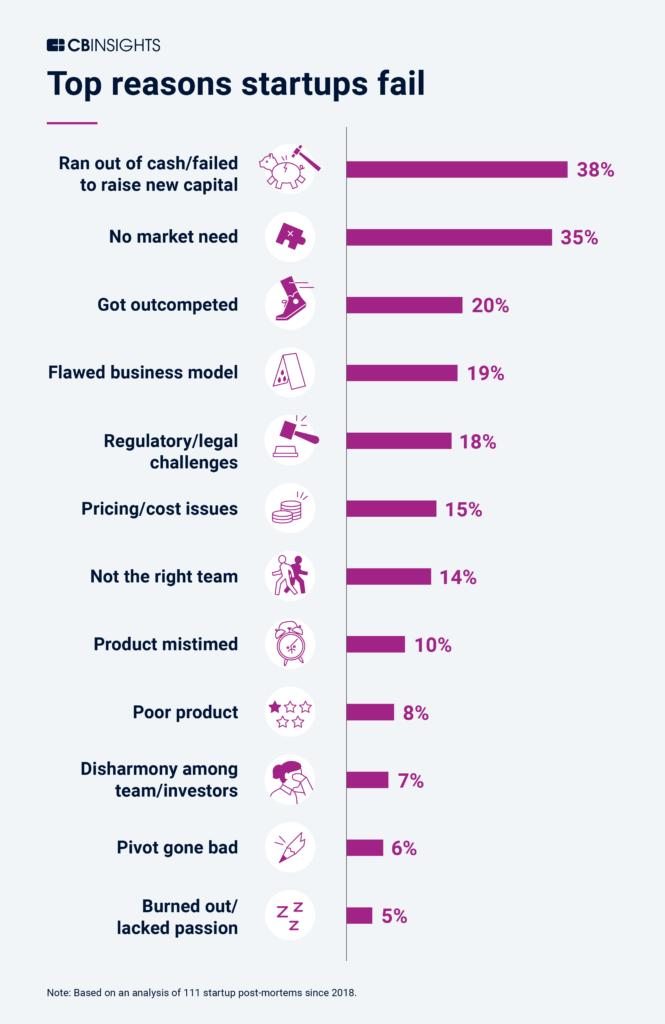35% of Startups Fail due to No Market Need
CB Insights’ latest report revealed that the #2 reason startups fail is due to “No Market Need”. Prior reports had this as the #1 reason, but it was displaced from the top spot by cash & funding issues. No surprise there if you’ve been reading the news. So, what can you do to avoid this failure trap? We’ll explore this in detail here, but first consider this quote we love:
The world doesn’t need more products. What it does need is better solutions to existing problems. So rather than asking yourself, ‘what product can I sell?’ instead ask, ‘what problem can I solve?’ @grettavanriel
Debilitating fear of failure is what holds so many entrepreneurs back from even starting, and that’s a damn shame! You don’t need to be first, as we’ll illustrate in an example below, and you don’t need to wait to have it perfect in order to have confidence in your idea. So read on, and don’t fear taking that first step.
How do you determine Market Need?
Channel your mad scientist!
Using a proven scientific method can help to inject some much-needed objectivity into your process. Founders love their own ideas, solving complex problems no one really cares about, solving problems they personally experience (which leads to confirmation bias), chasing a competitor’s success, and so on. No one is immune, and some succeed despite it, but your best bet is to follow as objective a process as possible.
For the sake of this blog post, we’ll share an (oversimplified) history of Intuit’s humble beginnines since it’s an excellent example of determining market need in a scientific way.
Observe
Scott Cook got the idea from witnessing his wife complaining about the time it took to pay the family bills and struggling to balance the checkbook.
Ask Questions
Cook wondered if other people felt the same way.
Develop a Hypothesis
Cook’s hypothesis was that many experienced the same frustration and didn’t like the current solution.
Run Experiments
He grabbed a few phone books (it was the 80’s after all) and called people at random asking them if they used the then-leading financial software.
Analyze Results
65% had tried it but only 4% actually using it.
Decide
Cook’s research revealed that people liked the idea and what it offered, after all 65% had tried it. But those same people didn’t like the experience they were currently getting, which is why only 4% were actually using it. He figured that if he addressed the needs (the “jobs to be done” by a better solution) he had a shot at getting market share. Tom Proulx, a student programmer at Stanford, wrote the first Quicken program in his dorm room and the two launched Intuit in a basement with 7 employees. Today Intuit is worth $120 billion, and Quicken is a household name in personal finances.
Modern-Day Approach to Determining Market Need
While the example above is excellent in illustrating basic scientific methodology, there are far more information and resources available to us today than in the 80’s, and FAR more competition and options as well. We can’t just pick up a phone book and call people. So what can you do instead?
- Observe & Ask Questions You can and should still do LOTS and LOTS of interviews with your target customers. Focus on the problem you’re solving, not the product you will sell, and the “jobs to be done” by the solution. Everyone is a bit harder to get to these days, but its the single most beneficial step you can take to determine market need and must not be skipped. So, hustle… then hustle some more. There’s no magic number to how many of these you need to do, but it’s likely more than you want to, so stick with it! Consider the following places:
- LinkedIn & Facebook Groups
- Meetups
- Google Surveys
- Networking events
- Ask your connections for referrals
- Market Research & Analysis There is more data available now than ever; use what exists. We do plan to cover this in-depth in a future article, sign up for HSTK Insights to get notified if you’re interested.
- Develop a Product-Market Fix Hypothesis Consider you’re most riskiest assumption that could threaten your success… For [product] to succeed, it is necessary that ____________.
- Run Experiments against your Riskiest Assumption(s) Here are 6 types of prototypes to consider; we cover these in depth in our Prototype Examples article
- Paper – hey, it’s free
- Powerpoint – yes, really
- Wireframes – a very basic, bare-bones visual of the flow
- Landing Page (a favorite!) – run ads to the site to validate interest, perhaps offer some signups or pre-orders
- UX/UI Shell – a semi-functional visual representation of what your solution will do once it’s developed
- MVP (Minimum Viable Product) – a bare bones solution
- Analyze Results What is the experience folks have with your solution? Would they recommend it to others? How would they feel if it were taken away? All of this points to FIT and NEED.
- Scale Up If you’re onto something – GO FOR IT. Scale up your solution.

Image Source: https://www.cbinsights.com/research/startup-failure-reasons-top/
